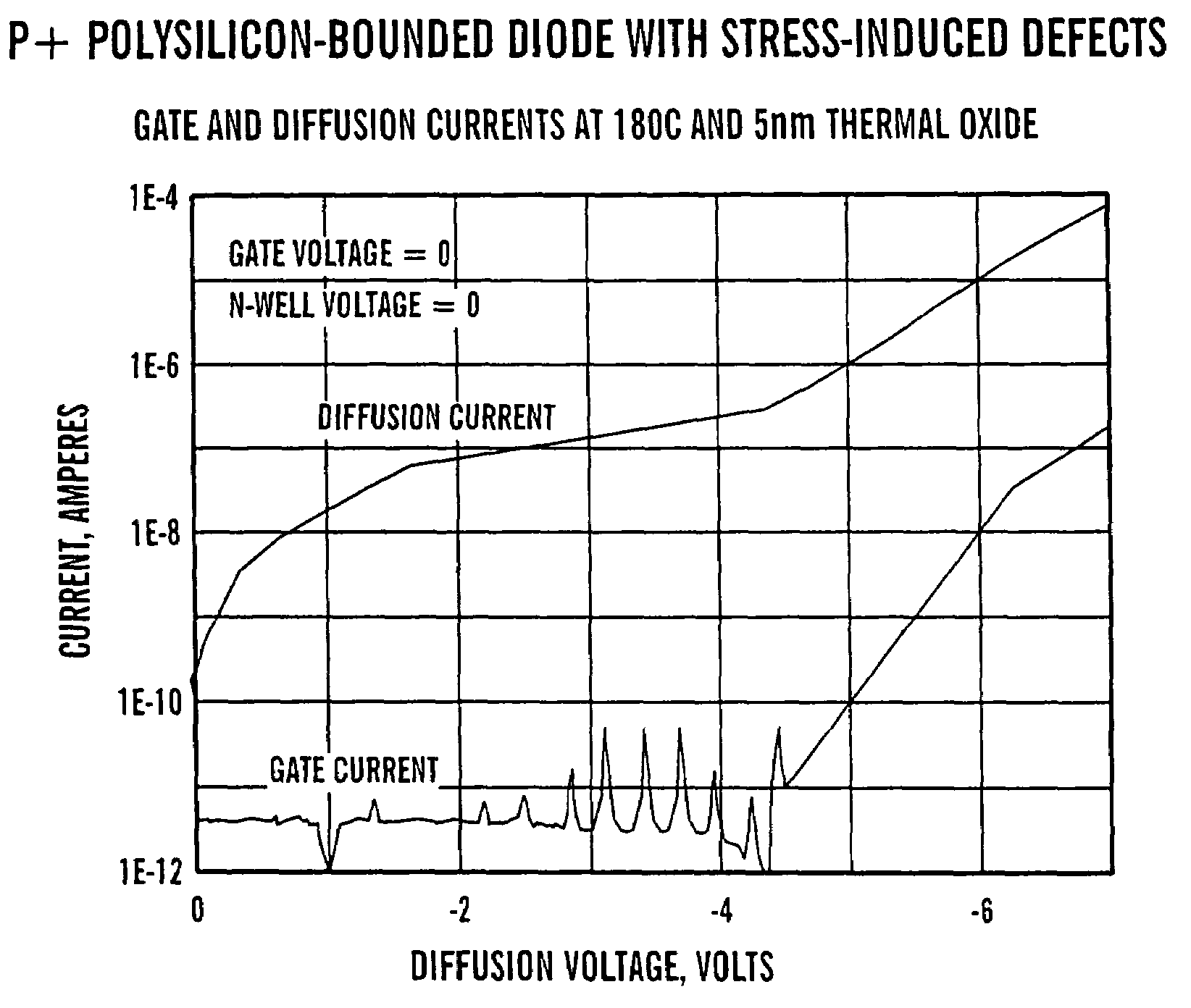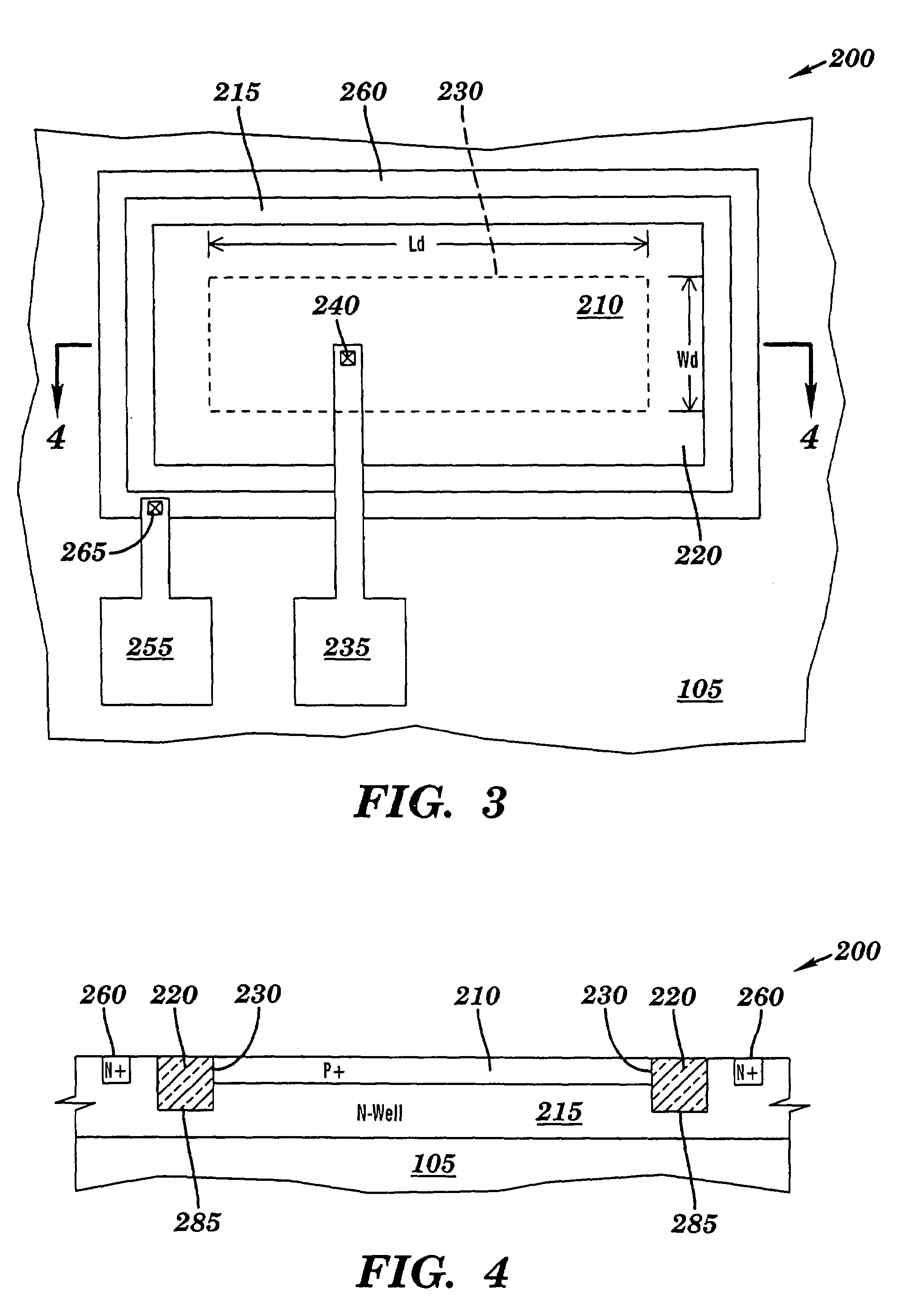Test structure and methodology for semiconductor stress-induced defects and antifuse based on same test structure
a test structure and stress-induced defect technology, applied in semiconductor/solid-state device testing/measurement, semiconductor device details, semiconductor/solid-state device testing/measurement, etc., can solve problems such as yield and reliability, degrade product functionality, and limited use of efficient and sensitive monitoring systems for stress-induced defects for both development and routine monitoring in manufacturing
- Summary
- Abstract
- Description
- Claims
- Application Information
AI Technical Summary
Benefits of technology
Problems solved by technology
Method used
Image
Examples
first embodiment
[0057]FIGS. 7A through 7C are flowcharts illustrating first, second and third test methodologies respectively, according to the present invention. Referring to FIG. 7A, in step 500, a polysilicon-bounded test diode 100 (see FIGS. 1 and 2) is selected. In step 505, polysilicon-bounded test diode 100 is maintained at a pre-selected temperature. In one example, the pre-selected temperature is 180° C. However, any temperature in the range of about 100 to 200° C. may be used. In step 510, polysilicon gate 125, N-well 115 and substrate 105 (see FIG. 1) are held at ground potential. In one example, ground potential is about 0 volts. In step 515, P+ diffusion region 110 (see FIG. 1) is ramped from about 0 volts to about −6 volts. In step 520, the current through polysilicon gate 125 (see FIG. 1) is monitored for current spikes. An example is illustrated in FIGS. 8 and 9 and described below.
[0058]Referring to FIG. 7B, in step 525, a test DRAM device 300 (see FIG. 5) is selected. In step 530,...
second embodiment
[0065]FIGS. 10A and 10B are flowcharts illustrating fourth and fifth test methodologies respectively, according to the present invention. Referring to FIG. 10A, in step 575, one or more polysilicon-bounded test diodes 100 (see FIGS. 1 and 2) is selected. In step 580, for each polysilicon-bounded test diode 100, polysilicon gate 125, N-well 115 and substrate 105 (see FIG. 1) are held at ground potential. In one example, ground potential is about 0 volts. In step 585, for each polysilicon-bounded test diode 100, P+ diffusion region 110 (see FIG. 1) is ramped from about 0 volts to about 0.85 volts. In step 590, for each polysilicon-bounded test diode 100, the current through P+ diffusion region 110 (see FIG. 1) is measured as a function of voltage and a frequency distribution analysis of the slope of the forward bias voltage / P+ diffusion current at a pre-selected forward bias voltage is performed. In step 595, one or more STI-bounded reference diodes 200 (see FIGS. 3 and 4) is selected...
third embodiment
[0080]FIGS. 13A, 13B and 13C are flowcharts illustrating sixth, seventh and eighth test methodologies respectively, according to the present invention. Referring to FIG. 13A, in step 670, one or more polysilicon-bounded test diodes 100 (see FIGS. 1 and 2) is selected. In step 675, each polysilicon-bounded test diode 100 is maintained at a pre-selected temperature. In one example, the pre-selected temperature is 160° C. However, any temperature in the range of about 100 to 200° C. may be used. In step 680, for each polysilicon-bounded test diode 100, N-well 115, substrate 105 and polysilicon gate 125 (see FIG. 1) are held at ground potential. In one example, ground potential is about 0 volts. In step 685, for each polysilicon-bounded test diode 100, a pre-determined voltage is applied to P+ diffusion region 110 (see FIG. 1) for at least a pre-determined time. In one example, the predetermined voltage is about −6.3 volts or less and the pre-determined time is about 0.5 hours or more. ...
PUM
 Login to View More
Login to View More Abstract
Description
Claims
Application Information
 Login to View More
Login to View More - R&D
- Intellectual Property
- Life Sciences
- Materials
- Tech Scout
- Unparalleled Data Quality
- Higher Quality Content
- 60% Fewer Hallucinations
Browse by: Latest US Patents, China's latest patents, Technical Efficacy Thesaurus, Application Domain, Technology Topic, Popular Technical Reports.
© 2025 PatSnap. All rights reserved.Legal|Privacy policy|Modern Slavery Act Transparency Statement|Sitemap|About US| Contact US: help@patsnap.com



